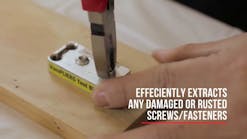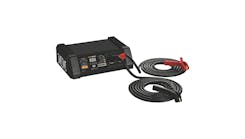When diagnosing a brake concern, the critical first steps are the road test and the visual inspection, as with all diagnoses. The visual inspection is the most valuable diagnostic tool in your toolbox. Once that step is complete, you will need the following tools to complete a quality job:
- Brake pad thickness gauge
- On-car brake lathe for resurfacing rotors
- High-quality silicone-based caliper slide grease
- Noise dampening products (available as an aerosol spray or as a paste in a bottle or a tube)
- Blockers to isolate hydraulic components
- Flare nut crowfoot
- Brake pressure bleeder
- Master cylinder bleeder kit
OTC makes a real nice brake pad thickness gauge that allows you to get an accurate reading of the inboard and outboard pads without removing the caliper, and in some cases, the wheel.
We use the Pro-Cut PFM 9.2 DRO. It's simple to hook-up, easy to move around the shop, and always produces a nice cut.
Wheel bearing grease is too thick, and white grease is too thin. Using the correct lubricant will prevent a high percentage of brake noise complaints. Permatex Silicone Ceramic Extreme brake parts lubricant applies evenly without running or wadding up.
RC Disc Brake Quiet aerosol spray works well because it sprays on evenly and dries quickly. It's crucial that the spray dries completely before installing the pads.
I've been using a set of Thexton blockers for years. They stand up well to the brake fluid without corrosion, and they seal perfectly.
The Sunex 9710M is a nice affordable 3/8 drive crowfoot set. They're small enough to fit between the lines, leaving enough room to get a good turn on the fitting.
There's no need to purchase an expensive electric or pneumatic pressure bleeder. I've been using the Mityvac MV6840 hand-pumped pressure bleeder. The unit keeps a constant 30 psi on the system.
Thexton makes a variety of good master cylinder bleeding kits. The right kit for you depends on which adapters you need for the models you service.
Read the complete article here.



